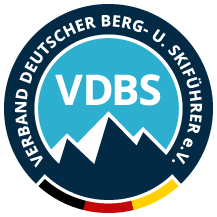Subchapter: Topographic map
Climber's topographic map
HOW TO READ AND INTERPRET IT
If you are going to climb alpine rock faces, you will need the most detailed information possible about the rock and the route. All this can be found on a topographic map: This is a graphic representation of a climbing route and can usually be found in a guidebook or on certain websites. The lead climber should always have the topographic map at hand when on the rock face.
Like any map, a topographic map uses symbols to represent information about the rock. Climbers can orient themselves on the basis of these standardized Symbols. Illustrations indicate the climbing direction, the length of each pitch and the number and type of belay points. Further indicators that can help with orientation include a logical route, the rock quality as well notable features on the rock.

What do the following topographc symbols mean?
Click on one of the symbols below to find out more.
Topographic symbols
Chimney
A vertical crevice in the rock which is more than the width of the body (> 60cm). Chimneys can be climbed by stemming or bridging
Chockstone
A large rock or stone wedged in a chimney or crack
Crack
A crevice that is smaller than a chimney, although at times the line between crevices and chimneys is blurred
Gully
A vertical recess surrounded by rocks
Dihedral
Two rock faces or slabs which converge in the shape of an open book, usually with an internal crack. Climbing dihedrals involves shifting pressure: alternating between stemming the legs and supporting with the arms
Edge
Usually small to very small horizontal ledges that make good hand and foot holds.
Slabs
Inclined rock with little structure. Friction is often used for climbing these
Overhang
Rock with an incline of more than 90 degrees that is therefore steeper than vertical. This requires arm strength, as climbing is exhausting
Roof
An almost horizontal overhang where climbing becomes more exhausting than on a vertical rock face
Ramp
Steeply rising ledge/sloping surface. Warning: Ramps can often remain damp after rain.
Ledge
: Horizontal pedestal on a rock face
Pedestal, shoulder
Cave / Hollow
Water streaks
Usually vertical erosion in limestone
Boulders/ rubble
Snowfield, firn field
Cornice
Heavily compacted, overhanging snow deposit on rock edges
Mountain pine
Sufficiently thick mountain pines can serve as intermediate belay points.
Tree
Sufficiently thick trees can be solid fixed points.
Grass
Warning: Steep grassy slopes are dangerous when wet
Fixed wire rope
Pendulum
Climber must cross a rock passage swinging on a fixed rope
Belay
Securing point to which the lead climber or follower is secured by the fixed partner.
Rappelling point
Designated route for abseiling.
Bivouac site
Key spot
Most difficult point on the climbing route
QUIZ: Reading a topographic map correctly
Like any map, a topographic map provides information about the route. The rope team can navigate the rock face based on the symbols on the topographic map. Now it’s your turn: Test your knowledge by completing the topographic map! On the route on the left you will find three terms from topographic maps – but the correct symbols are missing. Choose the correct symbol for each term and drag it onto the topographic map next to the term!
Not all symbols are correctly assigned.
Operations
Click on one of the free fields in the map to select an icon.

Which tophographic symbol is the right one?
Click on the field marked in the map to select the correct symbol.
Operations
Drag the correct icons from the list onto the map.
Like any map, a topographic map provides information about the route. The rope team can navigate the rock face based on the symbols on the topographic map. Now it’s your turn: Test your knowledge by completing the topographic map! On the route on the left you will find three terms from topographic maps – but the correct symbols are missing. Choose the correct symbol for each term and drag it onto the topographic map next to the term!
Not all symbols are correctly assigned.
Operations
Click on one of the free fields in the map to select an icon.

Which tophographic symbol is the right one?
Not all symbols are correctly assigned.
Operations
Drag the correct icons from the list onto the map.

